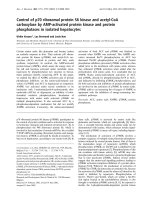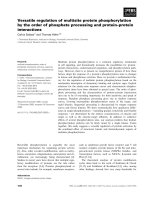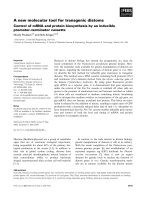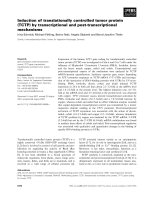Probing protein dynamics and protein protein interaction by NMR spectroscopy
Bạn đang xem bản rút gọn của tài liệu. Xem và tải ngay bản đầy đủ của tài liệu tại đây (3.05 MB, 151 trang )
PROBING PROTEIN DYNAMICS AND PROTEIN-
PROTEIN INTERACTION BY NMR SPECTROSCOPY
SUI XIAOGANG
A THESIS SUBMITTED FOR
THE DEGREE OF DOCTOR OF PHILOSOPHY
DEPARTMENT OF CHEMISTRY
NATIONAL UNIVERSITY OF SINGAPORE
2010
Dedicated to the fond Memories of my late grandmother
I
ACKNOWLEDGEMENTS
I would first like to express my deep gratitude to my adviser, Dr. Yang
Daiwen. His sustained support, kindness and dedication as research adviser and
enthusiastic teacher, have guided and helped me through my Ph.D. studies.
I would like to thank the committee members: Dr. Song Jianxing and Dr.
Jaenicke Stephan, for their help and useful suggestions.
I am sincerely grateful to all the co-workers whom I had worked with over the
years in Yang’s group, for always being helpful and for making the lab a pleasant and
inspiring workplace.
I will be forever grateful to my families. Without their unending and untiring
support, I cannot even start this thesis.
Finally, the research scholarship provided by NUS is gratefully acknowledged.
II
TABLE OF CONTENTS
ACKNOWLEDGEMENTS I
TABLE OF CONTENTS II
LIST OF ABBREVIATIONS V
LIST OF TABLES VII
LIST OF FIGURES VIII
SUMMARY XI
CHAPTER 1 GENERAL INTRODUCTION 1
1.1 History of NMR 3
1.2 Basics of NMR 5
1.2.1 Basic Theory 5
1.2.2 Relaxation Theory 7
1.2.2.1 Equation of Motion 7
1.2.2.2 Semiclassical Relaxation Theory 8
1.2.3 Relaxation Mechanisms 16
1.2.3.1 Intramolecular Dipole-Dipole Interaction 16
1.2.4 Expressions for Spectral Densities 18
1.2.4.1 Auto-correlated Dipolar(ij) Interaction 18
1.2.4.2 Cross-correlated Dipole(ij)-Dipole(kl) Interaction 18
1.2.5 Order Parameter 20
1.2.5.1 Lipari and Szabo Approach 20
1.2.5.2 Order Parameter 22
III
1.3 Outlines of the thesis 23
CHAPTER 2 PROBING PROTEIN SIDE-CHAIN DYNAMICS 24
2.1 Introduction 24
2.1.1 Backbone Dynamics and Side-Chain Dynamics 25
2.1.2 Review of Protein Side-Chain Dynamics Studies 27
2.1.3 Huntingtin Interaction Protein 2 32
2.2 Materials and Methods 35
2.2.1 NMR Spectroscopy 35
2.2.1.1 Experiments 35
2.2.1.2 Data Procession 36
2.2.1.3 Assignment of HIP2 Side-chain Methyl Groups 36
2.2.2 Extraction of Dynamics Parameters from Relaxation Data 38
2.2.2.1
13
C Relaxation Data: R
1
and Γ 38
2.2.2.2 Spectral Density Function 39
2.2.2.3 Rationality of S
2
Calculation 40
2.3 Results and Discussion 43
2.3.1 Measurement of
13
C Spin-Lattice Relaxation Rate 43
2.3.2 Measurement of Methyl Dipole-Dipole Cross-Correlated Relaxation
Rate 47
2.3.3 Extraction of Dynamic Parameters 56
2.3.4 Application to HIP2 protein 60
2.4 Conclusion 70
CHAPTER 3 PROTEIN INTERFACE MAPPING 72
3.1 Introduction 72
3.1.1 Review of NMR Mapping Approaches 74
IV
3.1.2 Hemoglobin 76
3.1.3 Distance Driven Docking 79
3.2 Materials and Methods 80
3.2.1 NMR Spectroscopy 80
3.2.1.1 Data Procession 80
3.2.2 Initial Relaxation Rate Measurement 81
3.2.3 Derivation of the Relaxation Equation 83
3.2.4 Effective Distance Measurement 85
3.2.5 Docking Study 89
3.3 Results and Discussion 91
3.3.1 Initial Relaxation Rate Results 91
3.3.2 Effective Distance Results 95
3.3.3 Docking Results 99
3.3.3.1 Hb A Dimer 99
3.3.3.2 Hb A Tetramer 99
3.4 Conclusion 106
CHAPTER 4 CONCLUSIONS AND FUTURE DIRECTIONS 107
4.1 Conclusions 107
4.2 Future Directions 109
APPENDIX 110
Appendix 1 111
Appendix 2 113
REFERENCE 114
V
LIST OF ABBREVIATIONS
This is a list of abbreviations in alphabetical order, to serve as a quick reference.
AIRs Ambiguous Interaction Restraints
ASA Accessible Surface Area
BMR Bloch–Wangsness–Redfield Theory
Da (kDa) Dalton (Kilodalton)
DD Dipole-Dipole
DR initial relaxation Rate Differences
E1(s) Ubiquitin Activating Enzyme(s)
E2(s) Ubiquitin Conjugating Enzyme(s)
E3(s) Ubiquitin Ligase Enzyme(s)
FID Free Induction Decay
FT Fourier Transform
HADDOCK High Ambiguity Driven biomolecular DOCKing
HIP2 Huntingtin interaction protein 2
VI
Hb A Human Adult Hemoglobin
LS Lipari and Szabo
NMR Nuclear Magnetic Resonance
NOE nuclear Overhauser effect
RF Radio Frequency
UB/UBL Ubiquitin/Ubquitin-Like Protein
VII
LIST OF TABLES
Table 2-1 Dynamics parameters of methyl groups in ubiquitin derived from spin-
lattice relaxation time T
1
and dipole-dipole cross-correlated relaxation Γ
55
Table 2-2 Dynamics parameters of methyl groups in HIP2 derived from spin-lattice
relaxation time T
1
and dipole-dipole cross-correlated relaxation Γ 65
Table 3-1 Effective distances (r
eff
) of -chain of Hb A estimated from amide
relaxation rates R1 and calculated from the R2 structure of Hb 98
Table 3-2 Hb A data to generate ambiguous interaction restraints (AIRs) 101
VIII
LIST OF FIGURES
Figure 1-1 Redfield kite. 13
Figure 2-1 Sequence and secondary structure of HIP2 (PDB Code: 1YLA) 34
Figure 2-2 Contour plot of errors (in percentage) in the measured
13
C{
1
H} NOE
values as a function of τ
e
and S
2
axis
for methyl groups in a uniformly
13
C-
labeled protein 42
Figure 2-3 Pulse sequence for the measurement of
13
C T
1
of methyl groups in
uniformly
13
C-labeled proteins 45
Figure 2-4 Contour plots of errors (in percentage) in the measured
13
C R
1
values as a
function of τ
e
and S
2
axis
for methyl groups in a uniformly
13
C-labeled
protein with an overall correlation time of 8 ns (a) or 15 ns (b) 46
Figure 2-5 Pulse scheme for the measurement of dipole-dipole cross-correlated
relaxation in methyl groups of uniformly
13
C,
15
N-labeled proteins 48
Figure 2-6 Comparison of the values of X=1+x calculated from Equation 2-14 (•) and
those estimated from Equation 2-15 and 2-16 (solid line, -) 51
Figure 2-7 Time dependence of the relative peak intensities of a number of
representative methyl groups in ubiquitin 54
Figure 2-8 Comparison of order parameters S
axis
2
determined from
13
C T
1
s and methyl
dipole-dipole cross-correlated relaxation rates versus the values
determined from
2
H relaxation times T
1
and T
2
58
IX
Figure 2-9 Comparison of internal effective correlation times
e
determined from
13
C
T
1
s and methyl dipole-dipole cross-correlated relaxation rates versus the
values determined from
2
H relaxation times T
1
and T
2
59
Figure 2-10
15
N T
1
, T
2
and NOE data with a corresponding secondary structure
topology 63
Figure 2-11
13
C-
1
H HSQC spectrum of HIP2 64
Figure 2-12 S
axis
2
values are mapped onto the solution structure of HIP2 (PDB Code:
1YLA). 68
Figure 2-13 S
2
values are mapped onto the solution structure of HIP2 (PDB Code:
1YLA). 69
Figure 2-14 Dimer interface of HIP2 in a surface model (PDB Code: 1YLA). 70
Figure 3-1 Sequence and secondary structure of Hb A (PDB Code: 1BBB) 78
Figure 3-2 Pulse scheme used to measure selective longitudinal relaxation times of
amide protons. 82
Figure 3-3 Changes of simulated intensity ratios (I
1
/I
2
) with relaxation delays for a
four-spin system 87
Figure 3-4 The dependence of intensity ratio (I
1
/I
2
) on the relaxation delay for a
number of representative residues 92
Figure 3-5 (a) Peak intensity ratios (I
1
/I
2
) against the residue number of the -chain of
Hb A (b) Difference of initial relaxation rates between samples 1 and 2 (c)
Comparison of effective distances derived from R
1
values () and from
the structure of R2 state of HbCO A (bar) 96
Figure 3-6 Relative intensities of the crosspeaks in the -chain of Hb A cross-
saturation spectra with irradiation centered at 1 pm with respect to those at
100 ppm 97
X
Figure 3-7 Backbone representation of a superposition of the 10 best scoring
1
1
docking structures.
1
and
1
are colored in blue and red, respectively . 102
Figure 3-8 Comparison of Hb A dimer between X-ray crystallographic structure (PDB
Code: 1BBB, blue) and the model obtained by docking two
1
1
dimers
(red) The comparison was made by superimposing Cα. The grey
rectangle shows the interface between
1
and
1
from Hb A 103
Figure 3-9 Comparison of Hb A tetramer between X-ray crystallographic structure
(PDB Code: 1BBB, blue) and the model obtained by docking 4 separated
subuntis together (red). The comparison was made by superimposing Cα
from
1
1
. 104
Figure 3-10 Comparison of Hb A tetramer between the X-ray crystallographic
structure (PDB Code: 1BBB, blue) and and the model obtained by
docking 4 separated subunits together (red). The comparison was made by
superimposing Cα. 105
XI
SUMMARY
NMR is one of the techniques for protein structure determination at the atomic
resolution. It is the only currently available technique to reveal protein dynamics on
per atom basis over a wide range of timescales in solution where physiological
conditions can be imitated. Although NMR experiments have been developed to
characterize protein dynamics for different purposes, protein side-chain dynamics is
still difficult to be obtained in a quantitative manner, especially for relatively large
proteins. Thus, the first objective of the thesis is to develop a method to probe side-
chain methyl dynamics.
In the first part of this thesis (Chapter 2), a novel method for probing methyl
dynamics based on dipole-dipole cross-correlated transverse relaxation and auto-
correlated longitudinal relaxation is presented. The excellent agreement between
dynamics parameters of methyl groups in ubiquitin obtained from the cross-correlated
relaxation and
13
C spin-lattice relaxation and those derived previously from
2
H
relaxation data, demonstrates the reliability and validity of this method. Subsequently,
the method was applied to the study of methyl dynamics of Huntingtin interacting
protein 2 (HIP2).
Currently, a variety of NMR based methods have been developed to identify
protein-protein interaction sites, but they are usually limited to special cases. The
second objective of this dissertation is to develop methods for mapping protein-
protein interaction interfaces.
XII
In the second part of this thesis (Chapter 3), a new strategy to map protein-
protein interfaces on the basis of the dependence of NMR relaxation on proton density
is presented. This strategy needs two moderately deuterated samples in which the
reporting protein in a protein-protein complex is
2
H-,
15
N-labeled while the acceptor
protein is either unlabeled or moderately
2
H-labeled. The method was demonstrated
by the identification of interfaces between human adult hemoglobin (Hb A) subunits.
The amino acids involved in Hb A inter-subunits interactions were unambiguously
identified from the measurement of the differences of initial relaxation rates of amide
protons between two samples that have different proton densities in the acceptor
protein. The upper limit of the effective distance between an amide proton and its
proximal protons was estimated from the differences of the initial relaxation rates in
the two samples. Based on the effective distances, we built a docking model of Hb A
dimer and tetramer in solution.
1
CHAPTER 1 GENERAL INTRODUCTION
Protein structure-function relationship is one of the major concerns for
molecular biology studies. To reveal this relationship, intensive efforts have been
made on protein structure determination. However, one has to note that a protein is
not naturally static but an equilibrium representation which consists of conformational
fluctuations. The fluctuations have crucial implications on protein functions, which
typically involve local rearrangement, domain-domain motions and/or overall
structural reorganizations (Kay 1998). This concept was first realized when the
structure of myoglobin was solved (Lehninger et al. 1993). The myoglobin structure
alone cannot reveal the diffusion pathway for oxygen to travel from the solvent to its
heme-binding site in the protein. The concept was realized again when the structure
of nef-SH3 was determined. The nef-SH3 structure alone cannot explain the loss of
binding free energy for the wild-type SH3 domain after it is bound to HIV-1 Nef
protein to form a protein complex (Arold et al. 1997). Therefore, to reveal a full
picture of protein functions, the static structure alone is not sufficient.
Protein-protein interactions, as another major concern in this field, are highly
related to protein functions. Protein-protein interactions studies are typically
benefited by high resolution structure determination, which provides a complete
description of interacting interface at atomic level. At present, the major experimental
2
structure determination approaches, NMR spectroscopy and X-ray crystallography,
are facing more challenges to study systems with an increasing molecular weight. For
NMR spectroscopy approach, spectra of a protein complex larger than 50 kDa, are
typically suffering from severe line broadening, which makes the resonance
assignment difficult to be accomplished. Moreover, considerable experimental time
for high-dimensional NMR experiments is a challenge to large protein’s stability. On
another hand, for X-ray crystallography approach, the main bottleneck is the
crystallization and resolution. So far, development of protein crystallization
technique is still on an empirical stage. It is also important to note that X-ray
structure may differ from fully hydrated structures, especially for protein complex
(Guo and Gmeiner 2001). Thereafter, a variety of methods have been developed to
map the protein-protein interactions without knowing the complex structures, such as
yeast two-hybrid system (Fields and Song 1989), affinity purification with MS/MS
identification (Aebersold and Mann 2003), methods based on fluorescence
technologies (Yan and Marriott 2004) and a variety of NMR spectroscopy approaches
(Zuiderweg 2002).
This thesis focuses on developing novel methods based on NMR relaxation
techniques to study protein structure-function relationship and to reveal protein-
protein interactions. Before starting our story, it is necessary to review a general
history and basic theories of NMR spectroscopy.
3
1.1 History of NMR
In 1890, prior to the discovery of NMR, Zeeman observed unusual behavior of
certain nuclei in a magnetic field. This phenomenon was later found to be due to
nuclear spin (Zeeman 1897). After several decades, NMR was first discovered
independently by Purcell et al. and Bloch et al. in 1946. Purcell observed NMR signal
from Paraffin wax (Purcell et al. 1946) and Bloch observed proton signal from water
(Bloch 1946; Bloch et al. 1946). Subsequently, Purcell and coworkers performed
NMR experiments on gaseous and solid samples (Purcell et al. 1946; Purcell et al.
1946) while Bloch established a semi-classical theory of spin relaxation (Bloch 1946).
In 1948-1949, Bloembergen and coworkers also established a theory for spin
relaxation (Bloembergen et al. 1948; Bloembergen 1949) while Gutowsky and Pake
discovered the huge potentials of NMR in the field of molecular structures (Gutowsky
and Pake 1948; Gutowsky et al. 1949). In 1950, Proctor and Yu discovered the
phenomenon of the chemical shift (Proctor and Yu 1950). One year after, Gutowsky
and McCall observed the J coupling effect (Gutowsky and McCall 1951). Meanwhile,
Hahn discovered spin echoes and developed several other methods for probing spin
dynamics and relaxation (Hahn 1949; Hahn 1950a; Hahn 1950b). In the subsequent
years, some notable discoveries are crucial to the development of contemporary NMR
spectroscopy, which include nuclear Overhauser effect (Overhauser 1953), cross
relaxations (Solomon 1955), and the analysis of diffusion effects (Torrey 1953;
Torrey 1956; Slichter and Ailion 1964). Meanwhile, Bloch and Redfield established
the most important theories for liquid spin dynamics (Bloch 1956; Redfield 1957).
4
In 1964, Ernst and Anderson firstly obtained NMR spectrum by applying
Fourier Transform (FT) of the free induction decay (FID) and demonstrated the
improvement in signal to noise ratio over the continuous wave method (Ernst and
Anderson 1966), which brought a new era of pulsed Fourier Transform NMR
spectroscopy.
In 1971, Jeener proposed the idea of two dimensional (2D) NMR spectroscopy
during a lecture, which was then realized by Aue et al. (Aue et al. 1976). The
applications of 2D NMR spectroscopy led to an emergence of new methods and
techniques. In the following years, 2D NMR spectroscopy was rapidly applied on the
detection of correlations between proton and carbon-13 spins (Maudsley and Ernst
1977; Maudsley et al. 1977), the indirect detection of multiple quantum transitions
(Wokaun and Ernst 1977a; Wokaun and Ernst 1977), investigations of chemical
exchange (Jeener et al. 1979; Meier and Ernst 1979), the detection of nuclear
Overhauser effects (NOE) (Kumar et al. 1980), and the determination of the first three
dimensional protein structure by Wüthrich and coworker (Williamson et al. 1985).
With the availability of NMR probe techniques to record multiple frequencies, 2D
NMR spectroscopy was soon extended to three and more dimensions (Cavanagh et al.
1996).
In this dissertation, we focus on the applications based on NMR relaxation
theories. The basics of NMR and its relaxation theory will be reviewed in the next
section.
5
1.2 Basics of NMR
NMR phenomenon bases on the magnetic properties of an atom’s nucleus. All
nuclei containing odd numbers of protons and some containing even numbers of
protons have magnetic moments. The nuclei are thus referred as being ‘magnetically
active’. NMR signals are detected by recording the evolution of the bulk
magnetization arising from the magnetically active nuclei.
1.2.1 Basic Theory
In the absence of a magnetic field, nuclear spins are randomly distributed.
When they are placed into a static magnetic field, the nuclear energy levels will be
subjected to Zeeman splitting. The Zeeman interaction is given by the following
Hamiltonian:
0
HB
1-1
where is the magnetic field and is the magnetic moment of the nuclei. Symbol
• indicates that and are vectors. The magnetic moment of a nucleus can be
written as:
1-2
where is the total angular momentum, is 1/2π times Plank’s constant and is the
0
B
0
B
I
I
6
gyromagnetic ratio. Assuming that a static homogeneous magnetic field is applied
along the z direction, the Hamiltonian is then written as:
1-3
The eigenvalues of , which are also known as spin quantum numbers (m),
are either odd multiples of ½ or integers. Hence, the energy at a given quantum
number or a energy state/level equals /2. According to the selection rule,
allowed transitions can take place between two energy levels such that the change in
the spin quantum number is:
1-4
Therefore, the resonant frequency for a spin system is expressed as:
1-5
The Zeeman Hamiltonian of a nuclear spin is defined as:
1-6
where ω is the resonant frequency of a nuclear spin (also known as Larmor Frequency)
and it is expressed as:
1-7
When a radio frequency (rf) field is applied on the spin system, transitions
take place, subject to the conditions of 1-4 and 1-7. When the excitation frequency
matches the Larmor frequency of the nuclear spins, the spin system absorbs energy
from the source of the rf field. Immediately after the absorption the spins start to
relax towards the equilibrium state.
In NMR spectroscopy, we monitor either the resonant absorption of the rf, or
the detection of the induced radio frequency in the receiver coil as the magnetization
rotates in the (x, y) plane, after the rf field is switched off.
0
B
0z
I
B
z
I
0
mB
m1
0
B
H
z
I
0
B
7
1.2.2 Relaxation Theory
NMR spin relaxation in liquids arises from random fluctuations of magnetic
fields associated with a variety of intramolecular and intermolecular interactions that
are modulated by molecular tumbling and other lattice motions. Redfield’s spin
relaxation framework is presented in this section. The detailed descriptions can be
found in Abragam’s book (Abragam 1961).
1.2.2.1 Equation of Motion
The time evolution of a quantum mechanical system, e.g. a single nuclear spin
system, under the influence of a static Hamiltonian H is given by the time-dependent
Schrödinger equation:
1-8
where H is expressed in units of and the time-dependent state function
contains all information about the coupled n-spin system. It can be decomposed into
a linear combination of time-dependent coefficients and eigenvectors of the
static Hamiltonian H which obey the time-independent Schrödinger equation
with
1-9
where E
i
is the energy of the eigenstate . Since NMR is an ensemble
() ()
d
itHt
dt
()t
()
i
ct
i
1
() () ,
n
ii
i
tct
iii
HE
i
8
spectroscopy, it is convenient to describe an ensemble of spin systems with its time
dependent density operator:
1-10
where the bar indicates averaging over the ensemble. The density operator belongs to
the 2n-dimensional Hilbert space and can be represented as a 2n×2n matrix with
respect to the basis set of the Hilbert space. The diagonal elements of the density
matrix correspond to the populations of the different energy levels E
i
of the
Hamiltonian H whereas the off-diagonal elements represent coherences resulting from
phase correlations of pairs of different eigenstates averaged over the ensemble.
The time evolution of the density matrix under the influence of the
Hamiltonian H is given by the Liouville-von Neumann equation:
1-11
which can be derived from the Schrödinger equation by assuming the subsystems of
the ensemble are non-interacting.
1.2.2.2 Semiclassical Relaxation Theory
The nuclear spin system is assumed to be a closed quantum system with some
perturbation from the lattice. The closed system in the absence of the lattice shows a
unitary and reversible time evolution. The concept of relaxation involves the
interaction between the spin system and the lattice; the interaction is assumed to be
weak so that the relaxations can be treated as perturbations. The microscopic
() () ()ttt
() , ()
d
tiHt
dt
9
semiclassical theory of spin relaxation established by Bloch and Redfield has been
proven to be useful to describe the experimental relaxation data in many cases. In the
semiclassical approach the spin system is treated quantum mechanically and the
surroundings are treated classically. This means that the density operator of the
energy levels of the lattice is assumed to be quasicontinuous with populations which
are described by Boltzmann distributions. Furthermore, the lattice is assumed to be in
thermal equilibrium at all times.
The total spin Hamiltonian of the spin system is described by the sum of the
time independent Hamiltonian H
0
and a stochastic Hamiltonian H’(t) which involves
the perturbation terms:
1-12
where consists of a Zeeman term for the coupling of the nuclear spins
to the external static magnetic field and a term for the time independent scalar spin-
spin coupling. We would not consider the chemical exchange processes and a
coupling of the spin system to a radio frequency field, which render these terms time-
dependent. The stochastic part H’(t) represents a stochastic process (typically
described by a diffusion equation) with a time average value of zero and is regarded
as a weak perturbation with respect to H
0
. It should be noted that the Hamiltonian
H’(t) consists of various relaxation Hamiltonians and it is the random fluctuations of
the spin system that give rise to stochasticity through the spatially dependent part of
the Hamiltonian.
Given the Hamiltonian H, all the needed information is contained in the
correlation matix of H’:
1-13
0
() '()Ht H H t
0
Z
J
HHH
''
'' ''
() () ( )GHtHt
†
10
It is assumed the G and are independent of time t, which is equivalent to
assuming that the external system of the bath which gives rise to H’(t), is stationary in
the statistical sense. The bar denotes an ensemble average. When H’ consists of two
different mechanisms namely, H1 and H2, correlation functions can be of two types.
Cross-correlation function, where two different mechanisms appear, shows the
correlation between two different mechanisms. For example, cross-correlation
functions can be written as
1-14
where i ≠ j. Auto correlation functions, in which i = j, are given by
1-15
Starting from the equation of motion of the density matrix in the
interaction picture, after performing second order perturbation expansion and some
algebraic manipulations, one obtains
1-16
where ‘*’ indicates the interaction representation that is given by
1-17
1-18
where
1-19
It is assumed that:
1) and are statistically independent and can be averaged
separately.
'H
'' , ,''
() () ( )
cross
ij
GHtHt
†
'' , ,''
() () ( )
auto
ii
GHtHt
†
*
*** ***
0
'(), (0) '(), '( ), (0)
t
d
iHt dHt Ht
dt
*1
UU
*1
''
H
UH U
0
exp( )UiHt
*
'()Ht
*
(0)
11
2) All unwritten higher order terms are negligible and the solution of Equation
1-17 with
*
(0)
replaced by
*
()t
describes the relaxation phenomena to sufficient
accuracy.
3) The weak collision approximation is applicable, that is,
1-20
where the assumptions that is the smallest time interval over which changes
and is the correlation time of the system, are valid, so that the upper limit of the
integration can be extended to +∞.
Solution of Equation 1-16 is true for a system in thermal equilibrium with a
lattice which is at infinite temperature. To get the realistic solution, where the system
evolve towards finite temperature equilibrium, the on the left-hand side is
replaced by . Since , ρ(∞)is different from zero and this
replacement introduces irreversibility in the equation of motion.
These assumptions simplify the equation of motion, to a form
1-21
When written in a matrix notation in a representation where the basis states are
the eigenstates and of the unperturbed Hamiltonian H
0
with eigenvalues α and
β, Equation 1-21 can be rewritten as
1-22
where because of the stationary character of the random Hamiltonian H’(t), the
coefficients are independent of time, and are linear combinations of spectral
»
c
t
t
*
c
*
()t
**
() ( )t
*
()
eq
****
0
' ( ), ' ( ), ( )
eq
d
dHtHt t
dt
=-
*('') *
''''
,'
(() )
it
eq
d
et
dt
''









